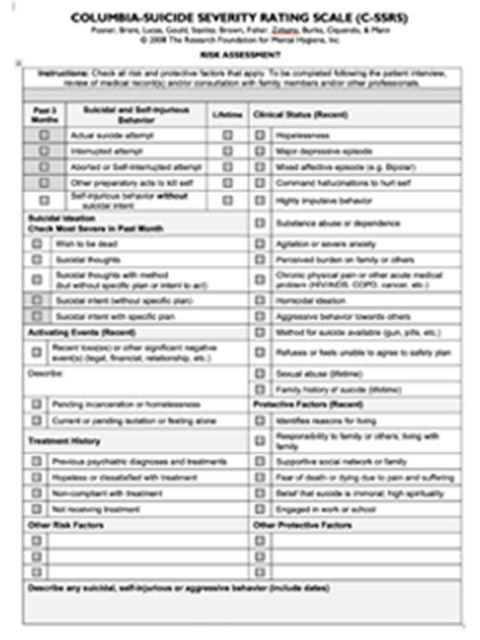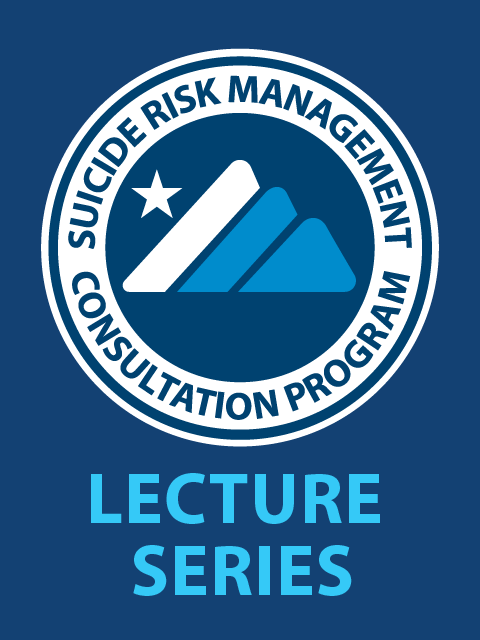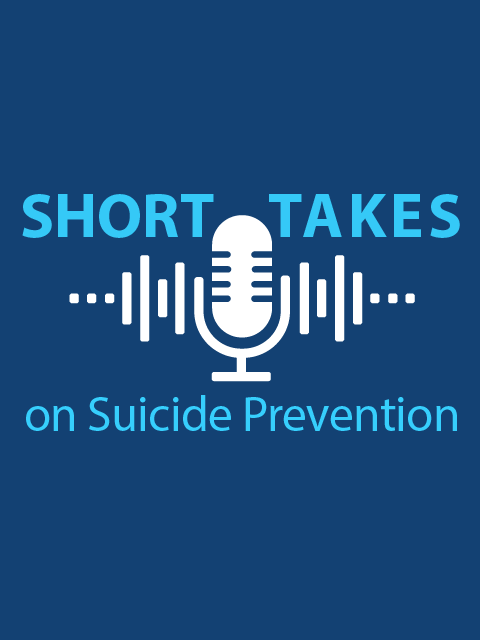3: Assessment of Risk Factors
Screening and Assessment » Assessment
3: Assessment of Risk Factors
When performing a suicide risk assessment, we suggest including, but not limited to, factors (see Table 6 below) within the following domains:
- Self-directed violence, thoughts, and behaviors
- Current psychiatric conditions and current or past mental/behavioral health treatment
- Psychiatric symptoms
- Social determinants of health and adverse life events
- Availability of lethal means
- Physical health conditions
- Demographic characteristics
Strength:
Weak for
Category:
ReviewedAmended
Grades and Definitions
- Strong for
- or "We recommend offering this option …"
- Weak for
- or "We suggest offering this option …"
- No recommendation
- or "There is insufficient evidence …"
- Weak against
- or "We suggest not offering this option …"
- Strong against
- or "We recommend against offering this option …"
Categories and Definitions |
||
|---|---|---|
| Evidence Reviewed* | Recommendation Category* | Definition* |
| Reviewed | New-added | New recommendation following review of the evidence |
| New-replaced | Recommendation from previous CPG that has been carried over to the updated CPG that has been changed following review of the evidence | |
| Not changed | Recommendation from previous CPG that has been carried forward to the updated CPG where the evidence has been reviewed but the recommendation is not changed | |
| Amended | Recommendation from the previous CPG that has been carried forward to the updated CPG where the evidence has been reviewed and a minor amendment has been made | |
| Deleted | Recommendation from the previous CPG that has been removed based on review of the evidence | |
| Not reviewed | Not changed | Recommendation from previous CPG that has been carried forward to the updated CPG, but for which the evidence has not been reviewed |
| Amended | Recommendation from the previous CPG that has been carried forward to the updated CPG where the evidence has not been reviewed and a minor amendment has been made | |
| Deleted | Recommendation from the previous CPG that has been removed because it was deemed out of scope for the updated CPG | |
| *Adapted from the NICE guideline manual (2012): The guidelines manual. London: National Institute for Health and Care Excellence;2012. and Martinez Garcia L, McFarlane E, Barnes S, Sanabria AJ, Alonso-Coello P, Alderson P. Updated recommendations: An assessment of NICE clinical guidelines. Implement Sci. 2014;9:72. | ||
Recommendation Resources
The goal of suicide risk assessment is to help providers determine a patient’s risk of suicide at a given point in time. Although suicide risk assessments have poor predictive value in identifying those at risk, they can identify factors that are contributing to a patient’s risk, which can facilitate treatment planning. Evaluation of risk factors is a crucial component of suicide risk assessment. Several factors have been associated with increased risk for suicide.
| Factor Category | List of Factors to Consider |
|---|---|
| Self-directed violence related |
|
| Current psychiatric conditions and current or past mental/behavioral health treatment |
|
| Psychiatric symptoms |
|
| Social determinants of health and adverse life events |
|
| Availability of lethal means |
|
| Physical health conditions |
|
| Demographic Characteristics |
|
Training and Clinical Resources
This section includes recommended trainings and clinical resources about the assessment of risk factors.
- VA Comprehensive Suicide Risk Evaluation (CSRE) printable worksheet
-
 The Columbia Risk and Protective Factors provides a checklist of risk and protective factors for suicide that can be used with any version of the Columbia Suicide Severity Rating Scale (C-SSRS)
The Columbia Risk and Protective Factors provides a checklist of risk and protective factors for suicide that can be used with any version of the Columbia Suicide Severity Rating Scale (C-SSRS) - Healthy People 2030: Social Determinants of Health
Webinars
This section includes recommended webinars about the assessment of risk factors.
-
 Financial Well-Being and Suicide Risk in Military Veterans Presented by Dr. Eric Elbogen
Financial Well-Being and Suicide Risk in Military Veterans Presented by Dr. Eric Elbogen -
 Firearm Acquisition & Ownership — Decision Making Within the Context of Injury Risk Presented by Dr. Joseph Simonetti
Firearm Acquisition & Ownership — Decision Making Within the Context of Injury Risk Presented by Dr. Joseph Simonetti -
 Neurocognitive Disorders and Suicide Presented by Dr. Joleen Sussman and Kelly Soberay, MA
Neurocognitive Disorders and Suicide Presented by Dr. Joleen Sussman and Kelly Soberay, MA -
 Preventing Suicide Among Veterans Experiencing Homelessness: Drivers or Risk and Tailoring Evidence-Based Care Presented by Dr. Ryan Holliday, Kenneth Bruemmer, Evan Polzer, MA and Shawn Liu, LCSW
Preventing Suicide Among Veterans Experiencing Homelessness: Drivers or Risk and Tailoring Evidence-Based Care Presented by Dr. Ryan Holliday, Kenneth Bruemmer, Evan Polzer, MA and Shawn Liu, LCSW -
 Suicide Prevention among those with Neurologic Conditions Presented by Dr. Lisa Brenner
Suicide Prevention among those with Neurologic Conditions Presented by Dr. Lisa Brenner -
 Suicide Prevention in Veterans with Substance Use Disorders Presented by Dr. James Haug and Erin Higgins, LCSW, LAC
Suicide Prevention in Veterans with Substance Use Disorders Presented by Dr. James Haug and Erin Higgins, LCSW, LAC -
 Suicide Risk Factors Research & Clinical Implications Presented by Dr. Megan Harvey and Christie Machan, LCSW
Suicide Risk Factors Research & Clinical Implications Presented by Dr. Megan Harvey and Christie Machan, LCSW -
 Suicide Risk and Prevention for Sexual and Gender Minority Populations Presented by Dr. John Blosnich
Suicide Risk and Prevention for Sexual and Gender Minority Populations Presented by Dr. John Blosnich -
 TBI, Suicide, and Evidence-Informed Intervention Strategies Presented by Dr. Lisa Brenner
TBI, Suicide, and Evidence-Informed Intervention Strategies Presented by Dr. Lisa Brenner -
 The Role of Relationships in Risk for Self-Directed Violence Presented by Dr. Danielle Weber
The Role of Relationships in Risk for Self-Directed Violence Presented by Dr. Danielle Weber -
 Treating PTSD in the Context of Suicidality Presented by Dr. Sadie Larsen and Dr. Lisa-Ann Cuccurullo
Treating PTSD in the Context of Suicidality Presented by Dr. Sadie Larsen and Dr. Lisa-Ann Cuccurullo -
 Understanding and Addressing Suicide Among Homeless and At-Risk Veterans Presented by Drs. Ryan Holliday and Jillian Weber and Mr. Shawn Liu, LCSW
Understanding and Addressing Suicide Among Homeless and At-Risk Veterans Presented by Drs. Ryan Holliday and Jillian Weber and Mr. Shawn Liu, LCSW -
 Understanding and Navigating Elevated Suicide Risk when Working with Justice-Involved Veterans Presented by Drs. Ryan Holliday, Matthew Stimmel, Alicia Desai and Ms. Katherine Stewart, LCSW
Understanding and Navigating Elevated Suicide Risk when Working with Justice-Involved Veterans Presented by Drs. Ryan Holliday, Matthew Stimmel, Alicia Desai and Ms. Katherine Stewart, LCSW
Podcasts
This section includes recommended podcast episodes about the assessment of risk factors.
- Rocky Mountain MIRECC Short Takes on Suicide Prevention
-
 Risk Factors, Warning Signs, and Drivers of Suicide with Dr. Peter Gutierrez
Risk Factors, Warning Signs, and Drivers of Suicide with Dr. Peter Gutierrez
Articles
This section includes recommended articles about the assessment of risk factors.
- (2019). Association of Firearm Ownership, Use, Accessibility, and Storage Practices With Suicide Risk Among US Army Soldiers. JAMA network open, 2(6). e195383. https://doi.org/10.1001/jamanetworkopen.2019.5383
- (2022). Risk factors for suicide in adults: systematic review and meta-analysis of psychological autopsy studies. Evidence-based mental health, 25(4). 148–155. https://doi.org/10.1136/ebmental-2022-300549
- (2017). Risk factors for suicidal thoughts and behaviors: A meta-analysis of 50 years of research. Psychological bulletin, 143(2). 187-232. https://doi.org/10.1037/bul0000084
- (2018). A longitudinal study of risk factors for suicide attempts among Operation Enduring Freedom and Operation Iraqi Freedom veterans. Depression and anxiety, 35(7). 609–618. https://doi.org/10.1002/da.22736
- (2020). Evaluation of Suicide Mortality Among Sexual Minority US Veterans From 2000 to 2017. JAMA network open, 3(12). e2031357. https://doi.org/10.1001/jamanetworkopen.2020.31357
- (2023). Associations Between Natural Language Processing-Enriched Social Determinants of Health and Suicide Death Among US Veterans. JAMA network open, 6(3). e233079. https://doi.org/10.1001/jamanetworkopen.2023.3079
- (2021). Risk factors for completed suicide in the general population: A prospective cohort study of 242, 952 people. Journal of affective disorders, 282. 707–711. https://doi.org/10.1016/j.jad.2020.12.132
- (2018). Risk factors for the transition from suicide ideation to suicide attempt: Results from the Army Study to Assess Risk and Resilience in Servicemembers (Army STARRS). Journal of abnormal psychology, 127(2). 139–149. https://doi.org/10.1037/abn0000317
- (2022). Midlife suicide: A systematic review and meta-analysis of socioeconomic, psychiatric and physical health risk factors. Journal of psychiatric research, 154. 233–241. https://doi.org/10.1016/j.jpsychires.2022.07.037
- (2021). Living alone, loneliness and lack of emotional support as predictors of suicide and self-harm: A nine-year follow up of the UK Biobank cohort. Journal of affective disorders, 279. 316–323. https://doi.org/10.1016/j.jad.2020.10.026
- (2023). Notes from the Field: Recent Changes in Suicide Rates, by Race and Ethnicity and Age Group - United States, 2021. MMWR. Morbidity and mortality weekly report, 72(6). 160–162. https://doi.org/10.15585/mmwr.mm7206a4
- (2023). Handgun Divestment and Risk of Suicide. Epidemiology (Cambridge Mass.), 34(1). 99–106. https://doi.org/10.1097/EDE.0000000000001549




















